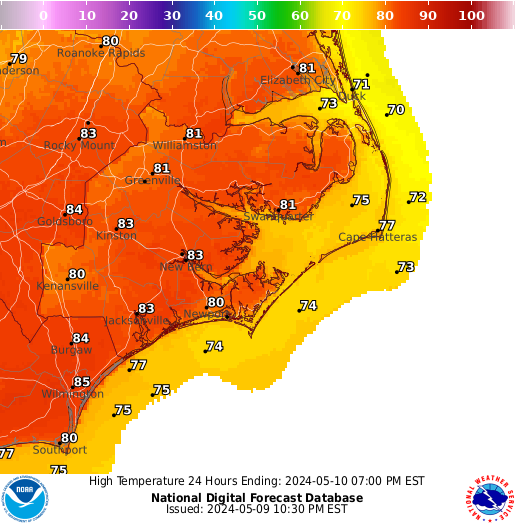Newport/Morehead City, NC
Weather Forecast Office
Tropical Storm Doria, August 25-28, 1971
Overview
Doria developed from a tropical wave on August 20, 1971 to the east of the Lesser Antilles, and reached tropical storm status to the east of Florida on August 25. Doria turned to the north (Figure 1), east of Florida, and made landfall near Morehead City on August 27 with maximum sustained winds around 65 mph, with gusts to 69 mph reported at Atlantic Beach. Doria then turned to the northeast and moved through the mid-Atlantic states and New England as a tropical storm before becoming extratropical over Maine on August 29.
Impacts
In North Carolina, Doria produced localized flooding and minor wind damage. Tropical Storm Doria dropped 4.17 inches in Cape Hatteras, with over 5 inches of rain falling around the Albemarle Sound and near New Bern. In localized areas, the flooding caused severe damage to roads and houses and damaged water and sewage systems. Doria also produced storm tides of 2 feet above normal along the southern Outer Banks coast.
Further north, the storm spawned a tornado near Norfolk, Virginia, damaging twelve houses and downing hundreds of trees. Doria dropped heavy rainfall (Figure 2) in New Jersey, with as much as 10.29 inches in Little Falls, leading to record-breaking river levels and widespread flooding (Figure 3) across the state. Peak rainfall amounts of over 11 inches occurred in Pennsylvania. Moderate damage and heavy rainfall was also noted in New England and into southeastern Canada. Tropical Storm Doria caused seven deaths and almost $150 million dollars in damage ($860 million in 2015 dollars), making it the costliest storm of the 1971 Tropical Season.

Figure 1. Track of Tropical Storm Doria, August 20-29, 1971.

Figure 2. Rainfall graphic from Tropical Storm Doria, August 25-28, 1971 (Courtesy David Roth, Weather Prediction Center).

Figure 3. Major flooding in New Jersey from Tropical Storm Doria, August, 1971. (Photo courtesy Associated Press)
Hazards
Skywarn
Submit Local Storm Reports
National Storm Report Viewer
Storm Prediction Center
National Hurricane Center
Rip Currents
Forecasts
Text Products
Tropical Weather
Activity Planner
Map View
Text Forecast
Area Forecast Matrices
Point Forecast Matrices
Forecast Discussion
Aviation Forecasts
Fire Weather Forecasts
Climate/Historical
Local Climate Page
National Climate Data
Local Significant Event Summary
Climate Plots
Tropical Cyclone Reports
Observations
Mesonet
Buoy Observations
Area Rivers
UV Index
Air Quality
Other Marine Reports
Marine Information
Local Marine Forecast
National Marine Information
Surf Zone Forecast/Rip Currents
Area Tidal Predictions
Ocean Prediction Center
Experimental Marine Portal
US Dept of Commerce
National Oceanic and Atmospheric Administration
National Weather Service
Newport/Morehead City, NC
533 Roberts Rd
Newport, NC 28570
252-223-5737
Comments? Questions? Please Contact Us.


.png) Surf Forecast/Rip Currents
Surf Forecast/Rip Currents Tropical Weather
Tropical Weather Map View
Map View Weather Hazard Briefing (when applicable)
Weather Hazard Briefing (when applicable) Forecaster Discussion
Forecaster Discussion Marine
Marine Text Products
Text Products.png) Skywarn
Skywarn Submit Storm Reports
Submit Storm Reports